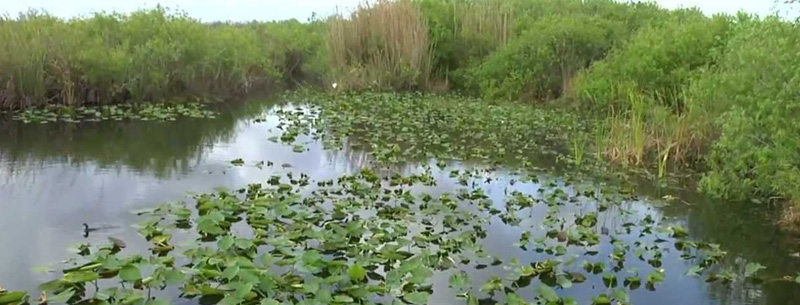No visit to Florida would be complete without seeing the grandeur that is the Everglades. Renowned throughout the world, the vast “river of grass” is a subtropical wetland that is home to hosts of rare birds, mammals, and reptiles. The park encompasses 1,506,539 acres, making it the third-largest park in the National Park System. The slow-moving river of water flowing through South Florida gives rise to diverse ecosystems. Coastal and saw grass prairies, mangrove swamps, tree islands, pinelands, hardwood hammocks, and coastal estuaries are all located within the lands the Calusa Indians called Pa-hay-okee, meaning “grassy waters.”
Everglades National Park has five separate entrances, each a gateway into a different area of the park. The main entrance to the southern portion features a wonderful visitors center, which contains some very informative exhibits and shows educational videos throughout the day. This portion of the park also showcases some of the most popular hiking trails, including the Anhinga Trail where many alligators and migratory birds congregate, and the Mahogany Hammock where the largest known mahogany tree in the country is located. In the northern portion of the Everglades, Shark Valley is the main attraction. A Tram Tour runs from this terminus several times daily and offers a great way to see some of the diverse wildlife and habitats in the park. In addition to hiking and tours, camping in the park can be a great adventure. Three campgrounds, at Long Pine Key, Flamingo, and Chekika, offer both tent and RV campsites with full hookups, and for the more adventurous, primitive backcountry camping is available at almost anywhere in the park with a permit. If luxury is your aim, the Flamingo Lodge offers both motel rooms and cottages within the park, and the lodge also offers a full-service marina and houseboat rentals. Seven canoe trails thread through the southern park region, including the 99-mile Wilderness Waterway. Canoe rentals are available at Nine Mile Pond and Westlake, or if you prefer a guided trip, through North American Canoe Tours.
The Flamingo section of the park – at the end of the main park road – holds virtually everything that makes the Everglades so special. Spend a day or two in this southerly portion of the park and you will begin to grasp the complex ecology of this park. The Florida Bay Cruise, a must for bird watchers, is a ninety-minute trip through the marine feeding and nursery grounds of Florida Bay.
A mile east of the Miccosukee Indian Village, visitors can go to Shark Valley. From here, you can see the vast sawgrass plains that stretch as far as the eye can see. The valley is best seen by renting a bike and riding the fifteen-mile loop road. A highly informative two-hour tram tour is also available. The tram tour stops frequently to view the amazing wildlife.
The park is open all year, but the best time to visit is winter. At this time, ranger-led activities are frequent and mosquitoes are bearable. In summer, park activities are reduced and afternoon storms frequently flood the prairies.
